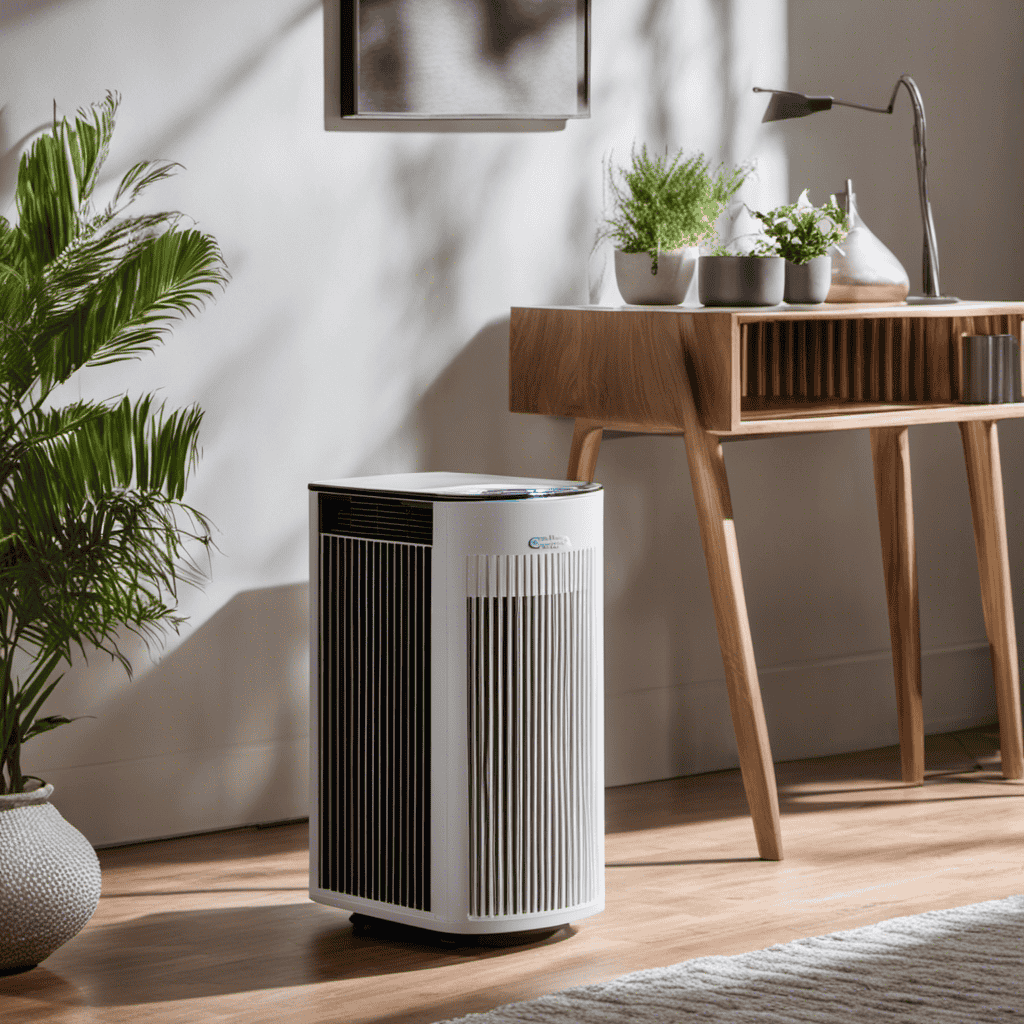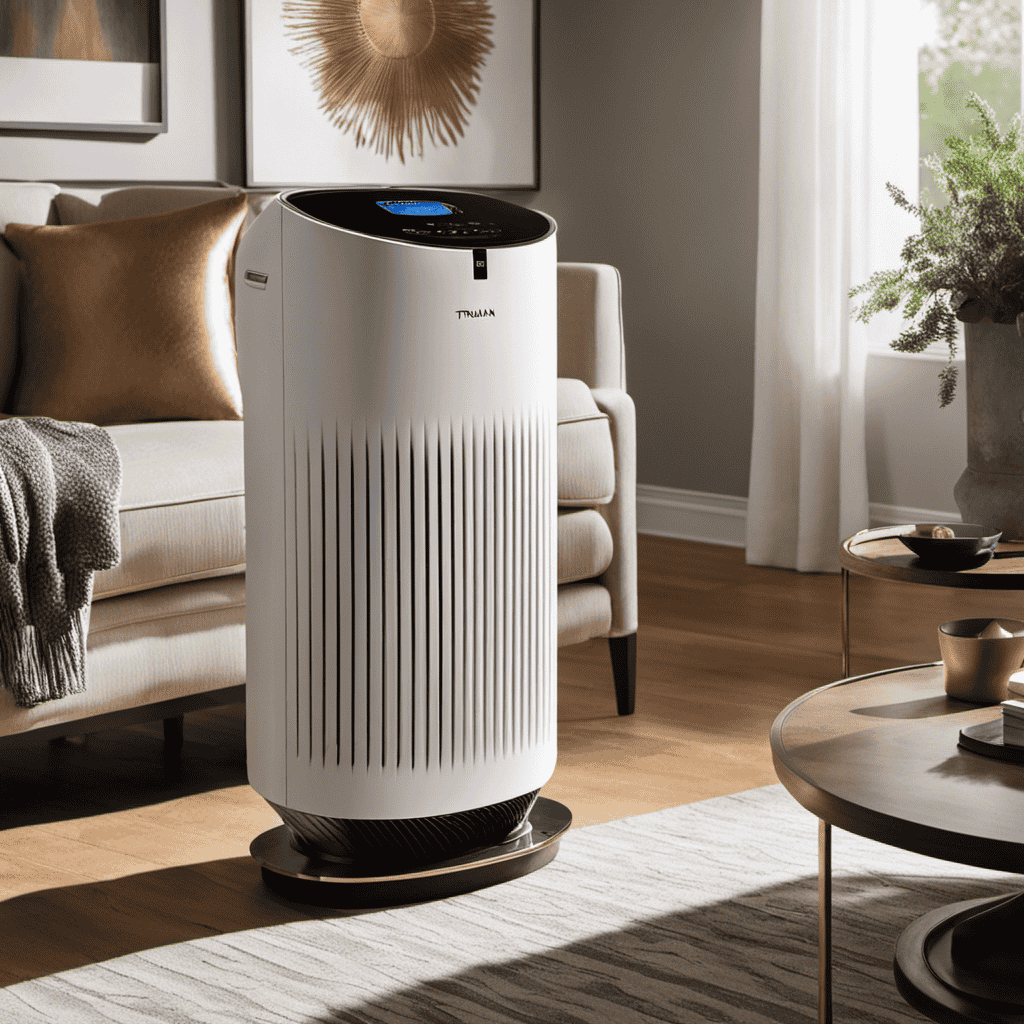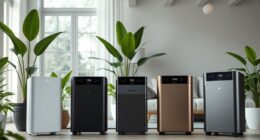Ever pondered the steps to rectify your air purifier’s malfunctioning? Fortunately, you’ve come to the right place as I’m set to walk you through the process of diagnosing and fixing the issue.
From common problems to cleaning and maintenance tips, I’ll provide you with all the knowledge you need to get your air purifier back up and running efficiently.
So, let’s dive in and discover the solutions to your air purifier woes!
Key Takeaways
- Regularly clean and replace filters for optimal air purification
- Check power cord connection and outlet for power supply problems
- Use baking soda, activated charcoal, essential oils, or vinegar and water solution to eliminate strange odors
- Follow proper cleaning and maintenance procedures to prolong the lifespan of the air purifier.
Common Air Purifier Problems
One of the most common air purifier problems is a clogged filter. When the filter becomes clogged with dust and debris, it hinders the purifier’s ability to effectively clean the air.
To troubleshoot this issue, start by turning off the purifier and unplugging it from the power source. Locate the filter, which is usually located at the back or side of the unit. Remove the filter from its housing and inspect it for any visible dirt or blockages.
If the filter is dirty, gently clean it using a soft brush or vacuum cleaner. If the filter is damaged or worn out, consider replacing it with a new one.
Regularly checking and cleaning the filter can prevent this common malfunction and ensure optimal performance of your air purifier.
Troubleshooting Steps for Air Purifier Issues
When it comes to troubleshooting air purifier issues, there are a few key points to consider.
First, power supply problems can often be easily resolved by checking the power cord and making sure it is securely plugged in.
Second, filter replacement is an important maintenance task that should be done regularly to ensure optimal air purification.
Lastly, if you notice a strange odor coming from your air purifier, there are solutions such as cleaning the unit or replacing the activated carbon filter to eliminate the odor.
Power Supply Problems
To fix your air purifier’s power supply problems, you’ll need to check if the power cord is securely plugged into the outlet. Power cord issues are a common cause of electrical malfunctions in air purifiers. Begin by ensuring that the cord is properly connected to both the purifier and the wall socket. Look for any signs of damage or fraying on the cord, as this can also lead to power supply problems. If you notice any issues, it is essential to replace the cord immediately.
Additionally, check the outlet itself to ensure it is functioning correctly. Sometimes, faulty outlets can cause power supply problems.
If you have ruled out these issues and are still experiencing power problems, it may be time to contact a professional technician for further assistance.
Filter Replacement Tips
Make sure you regularly replace the filters in your air purifier to maintain optimal performance. Filter maintenance is an essential part of air purifier maintenance, as dirty or clogged filters can reduce the efficiency of your purifier and allow pollutants to circulate in your home. To help you keep track of when to replace your filters, here is a table outlining the recommended filter replacement intervals for common types of air purifiers:
| Type of Filter | Recommended Replacement Interval |
|---|---|
| HEPA Filter | Every 6-12 months |
| Carbon Filter | Every 3-6 months |
| Pre-Filter | Every 1-3 months |
| UV-C Light | Every 6-12 months |
| Electrostatic | Every 3-6 months |
Strange Odor Solutions
If you’re experiencing a strange odor, try cleaning the filters in your air purifier to see if that helps eliminate the smell. Odors can be caused by a variety of factors, but there are some common household odors that can be effectively addressed with the right odor elimination techniques.
Here are four solutions to consider:
-
Baking soda: Place an open container of baking soda near the air purifier to absorb unpleasant odors.
-
Activated charcoal: Use activated charcoal to neutralize odors. Simply place some charcoal in a container and leave it near the air purifier.
-
Essential oils: Add a few drops of your favorite essential oil to the air purifier’s filter to freshen the air.
-
Vinegar: Mix equal parts water and vinegar and use the solution to wipe down the air purifier’s surfaces to eliminate odors.
Cleaning and Maintenance Tips for Your Air Purifier
Regularly cleaning and replacing the filters is essential for maintaining the efficiency of your air purifier. Many people overlook the importance of proper cleaning techniques when it comes to their air purifiers.
One common misconception is that simply wiping down the exterior of the purifier is enough. However, the filters are where the real cleaning happens. To start, always refer to the manufacturer’s instructions for specific cleaning guidelines. In general, most filters can be cleaned by gently vacuuming or rinsing them with water. It’s important to let them fully dry before reinserting them into the purifier.
Another misconception is that filters can last indefinitely. Over time, they become clogged with dust and debris, reducing their effectiveness. To ensure optimal performance, it’s recommended to replace the filters every 6-12 months, depending on usage.
Replacing Filters and Parts in Your Air Purifier
After ensuring that your air purifier is clean and well-maintained, it’s important to regularly replace filters and parts to keep it running efficiently. Proper air purifier maintenance will ensure that it continues to effectively remove allergens and pollutants from your indoor air.
Here are some tips for replacing filters and parts in your air purifier:
• Check the manufacturer’s instructions: Different air purifiers have different filter replacement schedules and procedures. Refer to the user manual for specific guidelines.
• Purchase the right filters: Make sure to buy the correct replacement filters for your air purifier model. Using the wrong filters can affect its performance and potentially damage the unit.
• Follow proper installation procedures: Take your time to carefully install the new filters and parts according to the manufacturer’s instructions. Incorrect installation can lead to decreased effectiveness and potential malfunctions.
• Keep track of replacement schedules: Set reminders or mark a calendar to keep track of when filters and parts need to be replaced. Regular replacement will ensure that your air purifier continues to function optimally.
Proper air purifier maintenance and timely filter replacements are essential for the long-term performance and efficiency of your air purifier. By following these guidelines, you can troubleshoot any issues and keep your air purifier running smoothly.
Tips for Improving Air Purifier Performance
To improve your air purifier’s performance, make sure you follow the manufacturer’s guidelines for filter replacements and installation.
In addition to regular maintenance, there are a few tips to enhance the effectiveness of your air purifier in improving air quality and reducing allergens.
Firstly, consider placing the air purifier in a central location in your home to maximize its coverage. This will ensure that the purified air is distributed evenly throughout the space.
Secondly, keep doors and windows closed while the air purifier is running to prevent contaminants from entering the room. Additionally, vacuum and dust your home regularly to minimize the amount of dust and particles that the air purifier needs to filter.
Finally, consider using a HEPA (High-Efficiency Particulate Air) filter in your air purifier. These filters are designed to capture a wide range of allergens and pollutants, including pet dander, pollen, and dust mites.
Professional Help and Repairs for Air Purifiers
When it comes to air purifier maintenance and repairs, there are a few key points to keep in mind.
First, DIY troubleshooting tips can be a great way to address minor issues and save money. From cleaning the filters to checking the power source, these tips can help you identify and fix common problems.
However, it’s also important to understand the importance of regular maintenance to prevent larger issues from arising. This includes regularly cleaning and replacing filters, as well as ensuring that the unit is operating efficiently.
DIY Troubleshooting Tips
If your air purifier isn’t working properly, try these DIY troubleshooting tips to get it back on track.
Here are some common issues and solutions to help you fix your air purifier:
-
Check for excessive noise: If your air purifier is making too much noise, it could be due to a dirty fan or loose parts. Clean the fan or tighten any loose screws to reduce the noise level.
-
Inspect the air purifier fan: If the fan is not spinning or is spinning slowly, it may be obstructed by dust or debris. Clean the fan blades and ensure there are no obstructions to allow proper airflow.
-
Change the filter: A clogged or dirty filter can hinder the performance of your air purifier. Replace the filter regularly to maintain optimal air quality.
-
Reset the unit: If your air purifier has a reset button, try pressing it to reset the device and resolve any minor issues.
Importance of Regular Maintenance
Regular maintenance is essential for keeping your air purifier in optimal condition and ensuring clean and fresh air in your home. By following some simple air purifier maintenance tips, you can enjoy the benefits of regular cleaning and prolong the lifespan of your device.
Firstly, it is important to clean or replace the filters regularly. This helps to remove dust, allergens, and other particles from the air effectively.
Additionally, cleaning the exterior of the purifier with a soft cloth and mild detergent helps to remove any dust or dirt buildup.
It is also recommended to check the fan and motor for any signs of damage or wear and tear.
Finding Reliable Repair Services
To ensure you find reliable repair services, it’s important to ask for recommendations from friends or family who have had similar appliances repaired in the past. They can provide valuable insights into the quality of service and affordability of different repair options.
In addition to personal recommendations, there are other strategies you can use to find reliable repair services. Consider checking online reviews and ratings for repair companies in your area. This can give you a sense of the experiences others have had with these services. You can also reach out to local consumer advocacy organizations for recommendations.
Finally, don’t underestimate the power of online repair tutorials. Many manufacturers and experts offer step-by-step guides that can help you troubleshoot and fix common issues with your air purifier. By combining these resources, you can find affordable repairs and ensure your air purifier is back in working order.
- Positive reviews from satisfied customers
- Affordable pricing options and discounts
- Quick and efficient repair turnaround time
- Friendly and knowledgeable customer service
Frequently Asked Questions
Can I Use My Air Purifier in a Large Room or Is It Only Suitable for Small Spaces?
Yes, you can use your air purifier in a large room. It is suitable for both small and large spaces. The benefits of using an air purifier in a large room include improved air quality and reduced allergens. Regular air purifier maintenance is key to optimal performance.
How Often Should I Replace the Filters in My Air Purifier?
I replace the filters in my air purifier every 3-6 months to maintain its effectiveness. Regular cleaning helps remove dust, allergens, and pollutants, improving indoor air quality and reducing allergy symptoms.
Can I Use Essential Oils or Other Fragrances With My Air Purifier?
Sure, you can use essential oils with your air purifier, but be cautious. Some oils can damage the purifier’s filters. Also, remember that air purifiers are better at removing pet odors than essential oil diffusers.
Is It Safe to Leave My Air Purifier on All Night While I Sleep?
Yes, it is safe to leave your air purifier on all night while you sleep. It not only helps maintain clean air throughout the night, but also provides various benefits for your health and overall well-being.
How Can I Tell if My Air Purifier Is Working Effectively?
To determine if your air purifier is effective, check for a noticeable reduction in dust, allergens, and odors. Also, ensure the filters are clean and the unit is running smoothly. Regular air purifier maintenance is key in troubleshooting common problems.
Conclusion
Well, after spending hours researching and troubleshooting, I finally managed to fix my air purifier. It’s amazing how something that is supposed to clean the air can cause so many problems. But hey, who needs fresh air anyway?
I mean, who wants to breathe in all that clean, pure oxygen? It’s overrated, right? So if you ever find yourself with a malfunctioning air purifier, just sit back, relax, and embrace the lovely scent of irony in the air.










